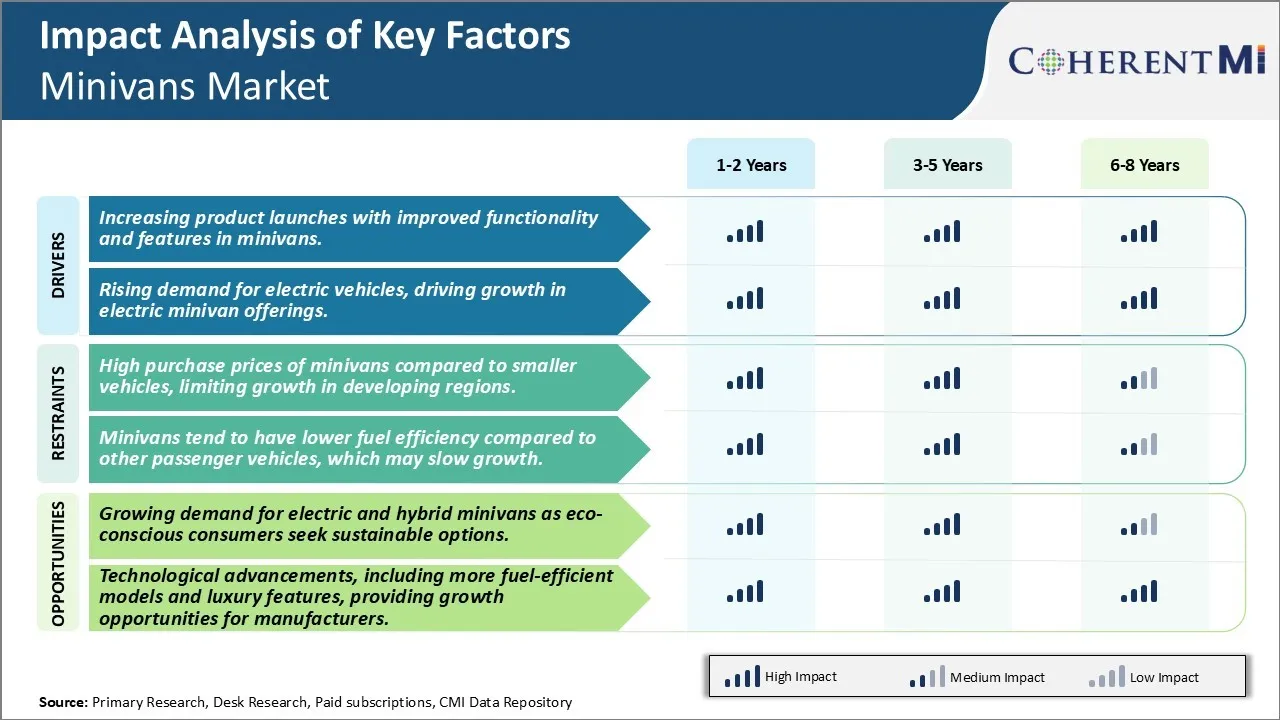Minivans Market Trends
Market Driver - Increasing Product Launches with Improved Functionality and Features in Minivans
Minivan manufacturers have recognized evolving customer preferences and demands for enhanced functionality, features, comfort and overall driving experience. As such, they are focusing on introducing new minivan models or refreshing existing lines with advanced technologies, improved designs and extra storage space. Several automakers have launched new minivans or heavily upgraded versions in the past couple of years with a focus on infotainment and connectivity, driver assist features, interior design and cargo utility.
One of the major players in the segment recently unveiled an all-new minivan for the 2023 model year with a host of upgrades over the prior generation. Some key highlights of the new design include LED headlights and taillights, revised front and rear fascias, new wheel options, expanded standard and available safety systems and revised power sliding doors and liftgate. On the inside, it sports a completely overhauled cabin with new seat fabrics, additional soft-touch materials and available second-row captain's chairs as well as SuperSlide second-row seats. The vehicle also gains the latest version of the automaker's Uconnect infotainment system with a larger touchscreen and support for both Apple CarPlay and Android Auto.
Another prominent manufacturer has also rolled out a redesigned minivan for 2023 with striking exterior and interior changes relative to the outgoing model. Some of the upgrades incorporated are redesigned front and rear ends, new wheel designs, standard LED headlights and available hands-free power sliding doors. The cabin receives noticeably premium styling, updated upholstery, second-row super console and available second-row captain's chairs. Advanced driver-assist features now include traffic sign recognition, intersection assist and highway assist. Moreover, onboard connectivity and infotainment are boosted through new standard and available technologies like a larger central touchscreen and wireless Apple CarPlay.
Market Driver - Rising Demand for Electric Vehicles, Driving Growth in Electric Minivan Offerings
With environmental regulations getting more stringent around the world and consumers becoming increasingly eco-conscious, demand for electric vehicles (EVs) is on a significant rise. Automakers are aggressively working to electrify their model lineups and also introduce new fully electric nameplates in order to comply with emissions standards as well as capitalize on the growing EV consumer base. The minivan segment has traditionally relied heavily on internal combustion engines. However, regulatory pressures and changing buyer preferences are now driving automakers to also develop electric minivan options.
A leading American automaker recently unveiled plans to roll out an all-electric version of one of its highly popular minivans by 2024. This would mark the brand's first battery-electric minivan on the market. The automaker has stated the new EV minivan will have a range of over 250 miles on a single charge and support fast charging capabilities. It will utilize the company's latest electric vehicle platform and drivetrain components. With styling similar to the gas-powered version, the electric variant aims to provide a practical family hauler without compromising on utility.
In Europe as well, automakers are bringing more electric options to the minivan segment. A major German premium brand has announced intentions to introduce a new all-electric minivan in mid-2024 based on its dedicated EV architecture. Slated to have a maximum range of over 300 miles, the upscale electric people mover will rival offerings from Tesla. Another European manufacturer has already debuted an electric version of one of its long-running minivans this year with a range exceeding 260 miles. This marks the brand's first battery-powered multi-purpose vehicle tailored for consumers seeking sustainability without compromises in practicality or comfort.

Market Challenge - High Purchase Prices of Minivans Compared to Smaller Vehicles, Limiting Growth in Developing Regions
One of the key challenges faced by the minivan market is the relatively high purchase prices of minivans compared to smaller passenger vehicles like hatchbacks or sedans. Minivans tend to be larger in size and offer more seating capacity, which increases manufacturing costs. This makes the initial price of a minivan significantly higher than a similarly specified smaller car. For many consumers in developing regions with lower average income levels, the high upfront cost prevents them from purchasing a minivan. As a result, minivan sales have struggled to grow substantially in developing markets like parts of Asia, Latin America, and Africa. With price-sensitive customers in these regions opting for cheaper smaller cars instead. For the minivan market to expand further globally, affordable options need to be made available. Manufacturers may have to consider lowering vehicle specifications, local sourcing of components, or offering attractive financing options to make minivans a viable purchase for a wider customer segment internationally. Unless this pricing challenge is addressed, it will continue limiting the market potential of minivans in developing parts of the world.
Market Opportunity- Growing Demand for Electric and Hybrid Minivans as Eco-Conscious Consumers Seek Sustainable Options
One major opportunity for the minivan market lies in the growing demand for electric and hybrid powertrain options. With rising environmental concerns, more consumers are seeking greener vehicle alternatives to traditional internal combustion engine vehicles. Minivans traditionally seen as practical family vehicles are also gradually gaining acceptance as sustainable mobility options. Several major automakers have either launched or announced plans to introduce electric or hybrid minivan models. This comes as consumer interest in emissions-free electric vehicles continues to increase. Recent surveys also indicate more families would consider buying an electric minivan if sufficient vehicle range and charging infrastructure was available. As automakers invest more in electrifying their model lineups, electric minivans provide a viable way to attract ecologically conscious customers into the minivan segment. With gas prices fluctuating and emission regulations tightening, the demand for efficient electrified minivans is expected to keep rising globally providing a major market opportunity.